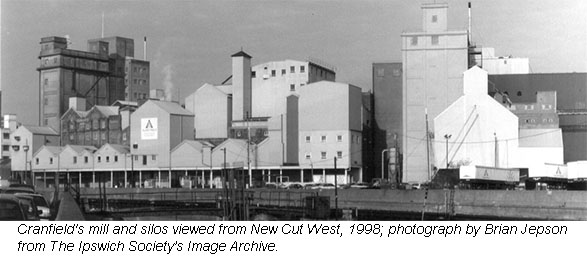- Screen Colours:
- Normal
- Black & Yellow
An encounter with a long gone Ipswich milling business
In the autumn of 1970 I enrolled on a Higher National Certificate in Business Studies at the then Ipswich Civic College, prior to going on to further Professional and Managerial Studies.
then Ipswich Civic College, prior to going on to further Professional and Managerial Studies.
At the time I was employed at the former East Suffolk County Council, in the Planning Section of the Clerk’s Department, where the section manager was Peter Steggall whom I later found out had an interest in windmills.
In the second year I had to produce a project on a business related topic. Not being employed directly in the world of business and commerce I wondered what I should do. I then remembered my CSE projects some six years earlier when, having to produce a history and a geography project, I decided on one topic. That topic was my home town of Ipswich. One project looked at the history of the town and the other on the geographical aspects. Problem solved: in the main I could adapt whatever information I found.
A route home for me from County Hall to over Stoke, where I lived, often involved a diversion along the dockside where I would watch the loaders at Cranfields Mills on the dockside stacking sacks of flour on lorries for distribution. On occasions I would see our neighbour Charlie Teager there, working on the loading gang. At that time I was one of the team at County Hall attending Planning Committee meetings at Lowestoft; given Peter Steggall’s interest in windmills we stopped on several occasions at Holton Post Mill near Halesworth and at Buttrums mill at Woodbridge. By this stage I had also bought my first car and could be mobile.
Then the light on the road to Damascus! Problem solved – a comparison of milling processes, ancient and modern. Criteria for project and interest satisfied in one go.
How did I progress from there? I already had some knowledge and material about how windmills worked. I went into the Suffolk Record Office, asked whether they had any financial accounts of a flour miller. After a while some accounts of the mill at Darsham near Saxmundham emerged. These provided an insight into the workings of the mill with receipts for grain, sales of flour and any mechanical expenses, such as repairs to the sails needed to harness the power of the wind.
I also explained the difference between Post Mills and Tower Mills, although the basic milling process was the same.
In the meantime, I had written (yes, written – no home phone, no internet) to Cranfields. I soon received a reply from Robin Armstrong the Mill Manager and went in to meet him. Ramrod straight, probably with some military service, dressed in a white coat, and wearing polished brogues he explained the history of Cranfields and the operation of the dockside mill. The height of the mill building meant that grain entered the process at the top, and then travelled down through the floors, until emerging as the finished flour, ready for bagging in hessian sacks.
He then introduced me to mill hand George, a one company man, dressed in blue serge overalls who knew everything from experience about the rolling milling process. We climbed the stairs to the top. In the first room, I noticed that the milling machinery had been supplied by Henry Simon Limited of Wythenshawe, Manchester. Henry Simon was a Prussian who emigrated to England; his first roller mill was for the McDougall brothers of Manchester. George explained, in his Suffolk accent, how the rolling mill process worked. Seven stages in all, each on a different floor, with the end product of each stage travelling by gravity through to the next floor and next stage.
1. Preparation; to remove the layers of bran and soften the endosperm (the edible part found between the skin and the germ of the grain) to reduce it during milling.
2. Breaking; to separate the endosperm from the bran and germ elements by breaking it into smaller pieces.
3. Sizing; separating small bran pieces from the larger pieces of endosperm according to size and density, by means of sifting.
4. Reduction; converting the endosperm into flour.
5. Tailings; separating the remaining bran from any endosperm
6. Blending; adjusting the content of the flour according to what it will be used for, e.g. the difference between plain and self-raising.
7. Final treatment; perhaps enriching or bleaching the flour.
The sound of the machinery was deafening, but George stuck to his task, and imparted to me, a totally untechnical person, sufficient knowledge of the process. We had worked our way down from top to bottom of the mill.
The whole visit took some two hours and, after thanking George and Robin Armstrong, I emerged into Quay Street.
Flour is an essential ingredient in cake-making. The final ‘icing on the cake’ for me was to use my new found mobility and Ford Anglia to travel around East Suffolk. Using my Instamatic Camera I took photographs of windmills such as those at Framsden, Friston, Buttrums (Woodbridge) and Holton, to illustrate my work, aided by some brochures obtained from Henry Simon Ltd.
A very useful project to carry out as a 21 year old – it satisfied the needs of my course whilst also stimulating my own interest in the milling industry. It also gave experience useful in later years when I had to produce a dissertation for my MBA; the subject matter was a company I enjoyed working with. No problem then.
Sadly, the accounts of the Darsham Mill no longer appear to be in the archives at The Hold.
Graham Day
